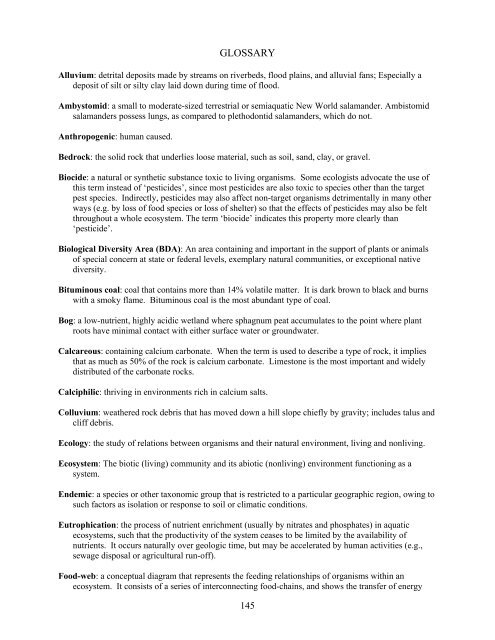introduction - Pennsylvania Natural Heritage Program
introduction - Pennsylvania Natural Heritage Program
introduction - Pennsylvania Natural Heritage Program
You also want an ePaper? Increase the reach of your titles
YUMPU automatically turns print PDFs into web optimized ePapers that Google loves.
GLOSSARYAlluvium: detrital deposits made by streams on riverbeds, flood plains, and alluvial fans; Especially adeposit of silt or silty clay laid down during time of flood.Ambystomid: a small to moderate-sized terrestrial or semiaquatic New World salamander. Ambistomidsalamanders possess lungs, as compared to plethodontid salamanders, which do not.Anthropogenic: human caused.Bedrock: the solid rock that underlies loose material, such as soil, sand, clay, or gravel.Biocide: a natural or synthetic substance toxic to living organisms. Some ecologists advocate the use ofthis term instead of ‘pesticides’, since most pesticides are also toxic to species other than the targetpest species. Indirectly, pesticides may also affect non-target organisms detrimentally in many otherways (e.g. by loss of food species or loss of shelter) so that the effects of pesticides may also be feltthroughout a whole ecosystem. The term ‘biocide’ indicates this property more clearly than‘pesticide’.Biological Diversity Area (BDA): An area containing and important in the support of plants or animalsof special concern at state or federal levels, exemplary natural communities, or exceptional nativediversity.Bituminous coal: coal that contains more than 14% volatile matter. It is dark brown to black and burnswith a smoky flame. Bituminous coal is the most abundant type of coal.Bog: a low-nutrient, highly acidic wetland where sphagnum peat accumulates to the point where plantroots have minimal contact with either surface water or groundwater.Calcareous: containing calcium carbonate. When the term is used to describe a type of rock, it impliesthat as much as 50% of the rock is calcium carbonate. Limestone is the most important and widelydistributed of the carbonate rocks.Calciphilic: thriving in environments rich in calcium salts.Colluvium: weathered rock debris that has moved down a hill slope chiefly by gravity; includes talus andcliff debris.Ecology: the study of relations between organisms and their natural environment, living and nonliving.Ecosystem: The biotic (living) community and its abiotic (nonliving) environment functioning as asystem.Endemic: a species or other taxonomic group that is restricted to a particular geographic region, owing tosuch factors as isolation or response to soil or climatic conditions.Eutrophication: the process of nutrient enrichment (usually by nitrates and phosphates) in aquaticecosystems, such that the productivity of the system ceases to be limited by the availability ofnutrients. It occurs naturally over geologic time, but may be accelerated by human activities (e.g.,sewage disposal or agricultural run-off).Food-web: a conceptual diagram that represents the feeding relationships of organisms within anecosystem. It consists of a series of interconnecting food-chains, and shows the transfer of energy145










